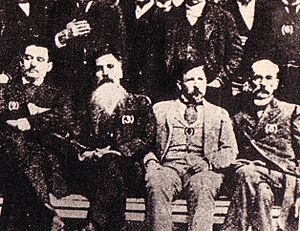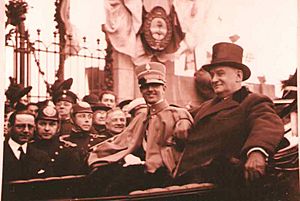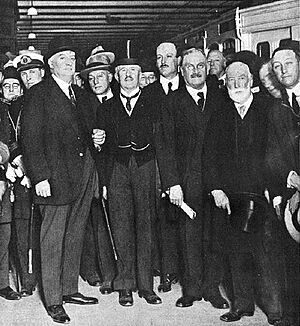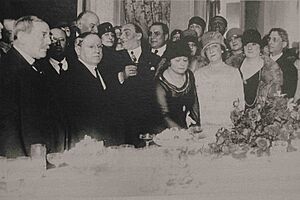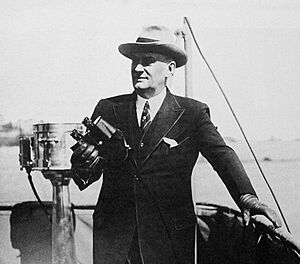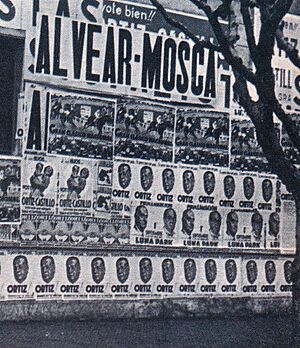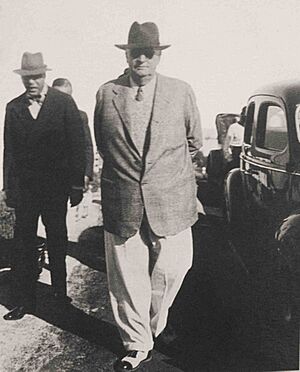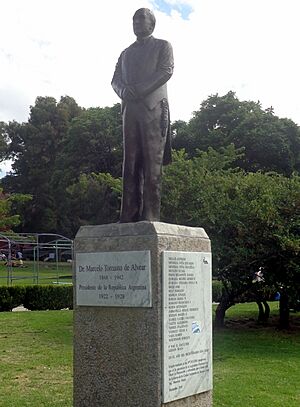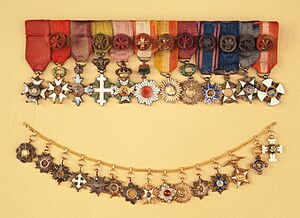Marcelo Torcuato de Alvear facts for kids
Quick facts for kids
Marcelo Torcuato de Alvear
|
|
|---|---|
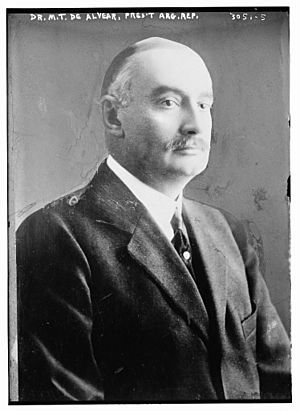 |
|
| President of Argentina | |
| In office 12 October 1922 – 12 October 1928 |
|
| Vice President | Elpidio González |
| Preceded by | Hipólito Yrigoyen |
| Succeeded by | Hipólito Yrigoyen |
| President of the Radical Civic Union National Committee | |
| In office December 1931 – 23 March 1942 |
|
| Preceded by | José María Martinez |
| Succeeded by | Gabriel Oddone |
| Personal details | |
| Born |
Máximo Marcelo Torcuato de Alvear Pacheco
4 October 1868 Buenos Aires, Argentina |
| Died | 23 March 1942 (aged 73) Don Torcuato, Buenos Aires, Argentina |
| Resting place | La Recoleta Cemetery Buenos Aires, Argentina |
| Political party | Radical Civic Union |
| Spouse | Regina Pacini |
| Alma mater | University of Buenos Aires |
| Profession | Lawyer |
| Signature |  |
| Military service | |
| Allegiance | |
| Branch/service | |
| Rank | Lieutenant colonel |
Máximo Marcelo Torcuato de Alvear Pacheco (born 4 October 1868 – died 23 March 1942) was an Argentine lawyer and politician. He served as president of Argentina from 1922 to 1928.
His time as president happened after a big world crisis. This helped him improve Argentina's economy and money situation. He also helped grow the automotive industry and successful oil production. This made Argentina very rich, and its GDP per person became the sixth highest in the world by 1928. During his presidency, many people moved to cities, and about half a million immigrants arrived. The middle class grew, wages increased, and there were fewer strikes.
After his presidency, he moved to France. He came back a few years later to unite his political party. He wanted to be president again in 1931, but the military government stopped him. Alvear and other radical leaders were often arrested or sent away. He even spent time in Martín García prison. Marcelo Torcuato de Alvear died on 23 March 1942 from a heart attack at his home in Don Torcuato, Buenos Aires, with his wife Regina Pacini by his side.
Contents
Early Life and Education
Máximo Marcelo Torcuato de Alvear was born on 4 October 1868 in the city of Buenos Aires. His parents were Torcuato de Alvear and Elvira Pacheco y Reinoso. His family, the Alvears, was a very rich and important family from the Basque region.
His great-grandfather, Diego de Alvear y Ponce de León, was a Brigadier General in the Spanish Navy. His grandfather, Carlos María de Alvear, was a supreme leader of the United Provinces of the Río de la Plata. His father, Torcuato de Alvear, was the mayor of Buenos Aires.
Young Alvear had a typical youth for someone from a wealthy family. He enjoyed the social life of Buenos Aires. He started at the National College of Buenos Aires in 1879. His studies were not always regular, but he finished high school in 1885. In 1886, he began studying Law at the University of Buenos Aires. He studied hard and got good grades. He finally became a lawyer in 1891, a year after his father passed away.
Alvear and his friends, like José Luis Cantilo and Fernando Saguier, were known for being a bit rebellious. Sometimes, their actions even led to some of them being put in jail.
Marcelo Alvear was a wealthy man and traveled a lot in Europe. In 1906, he married the opera singer Regina Pacini in Lisbon. Even though he was far away, he kept up with what was happening in Argentina. He was always interested in the radical party's fight for fair elections.
Political Beginnings
Alvear played a key role in organizing a big meeting in Florida Garden on 1 September 1889. This meeting helped make Leandro N. Alem popular among young people in Buenos Aires. The plan for the Revolution of the Park was also made at this meeting. Alvear helped organize the successful event. After this, he worked as Alem's secretary. He also joined the Unión Cívica when it was founded in 1890.
In 1891, the Civic Union split into two groups. One group supported Leandro N. Alem, and the other supported Bartolomé Mitre. Alvear chose to stay with Alem's side. He was one of the people who signed the paper on 2 July that created the Unión Cívica Radical. Later that year, Alvear traveled with Alem to promote the candidates Bernardo de Irigoyen and Juan M. Garro.
On 30 July 1893, Alvear was told to join a radical revolution. He and other young people took over the Temperley police station. A few days later, Hipólito Yrigoyen arrived with 1500 men. They had started a revolt across the province of Buenos Aires. Yrigoyen and 4000 men entered the city and were cheered by the people.
In 1912, the Sáenz Peña law was passed, which made voting secret and required. Because of this, the radicals stopped avoiding elections. Alvear was then elected as a national deputy for the capital. Soon after, he became the president of the Jockey Club.
Regina Pacini and Life in France
In 1898, Alvear met the Portuguese soprano Regina Pacini, who would become his wife. She was performing in Buenos Aires at the General San Martín Municipal Theater. At first, she wasn't interested in him. So, Alvear traveled to Europe and followed her for eight years. At that time, it was unusual for a wealthy aristocrat to marry an artist.
They finally married on 29 April 1907, in a church in Lisbon. After their wedding, Alvear and Pacini lived in Paris for several years.

Deputy and Ambassador
Alvear was elected as a deputy for the province of Buenos Aires. He worked hard in parliament. He proposed a law to make sure government jobs were given based on skills and experience. He also worked on laws for the civil code and army organization. He supported creating a Gendarmerie to protect Argentina's borders, but this idea didn't pass.
In 1916, the new president, Hipólito Yrigoyen, offered Alvear the job of Minister of War, but Alvear said no. Then, Yrigoyen offered him to be ambassador to France, which Alvear accepted. He held this job until 1922. During World War I, Alvear helped the allies in Paris. He and his wife, Regina Pacini, even donated a war hospital and a blood bank. Pacini helped care for the wounded there. Alvear also helped with selling crops to the allies during the war.
This is when Alvear and Yrigoyen started to disagree. Yrigoyen wanted Argentina to stay neutral in the war, but Alvear believed Argentina should support the Triple Entente.
1922 Presidential Election
After Hipólito Yrigoyen's first term as president, there was a question about who would be the next president. There were disagreements within the UCR party. In March 1922, the party's National Convention chose Alvear as their candidate. At that time, Alvear was the ambassador to France. He was from a more traditional part of the UCR and didn't have strong ties to the party's popular base.
The Alvear-González team won the election on 2 April 1922. They won in almost all areas of the country. Alvear became president with 47.5% of the votes. On 12 June, 235 radical voters confirmed Alvear as the Nation's president. He was still living in France at the time. European governments were happy with Alvear's election because he was seen as a leader who understood Western politics.
Alvear's Presidency (1922-1928)
Marcelo Torcuato de Alvear became president of Argentina on 12 October 1922. His choice of ministers surprised many radicals. Most of his ministers were not supporters of the former president, Yrigoyen. This caused a growing distance between Alvear and Yrigoyen. Some of his appointments were unexpected, like Admiral Manuel Domecq García, who had been tough on striking workers during Yrigoyen's time. General Agustín Pedro Justo was also appointed.
The ceremony where Alvear took office was broadcast on the radio. This was the first time in Argentina's history that a president's voice was heard on the radio. Alvear also visited the Jockey Club, something Yrigoyen had refused to do for six years.
Economic Growth
Argentina's economy grew a lot during this time, with an average growth of 8.1% each year. Alvear's government started just as the world crisis after World War I was ending. This helped the economy improve without major problems.
During his presidency, Argentina's economy was very strong. The GDP per person in 1928 was the sixth highest in the world. The country's income increased by nearly 100 million gold pesos. For three years, Argentina sold more goods to other countries than it bought. This happened because European countries, recovering from the war, bought many Argentine crops. So, Alvear's government focused on exporting farm products, especially meat and grains.
By 1925, Argentina supplied a large part of the world's exports of flax (72%), corn (66%), and meat (50%). Industrial crops like cotton also grew a lot. In 1922, the first Ford car factory in Latin America was built in Argentina. A year later, the state-owned oil company YPF opened its first gasoline pump. In 1925, the popular Ford T car went on sale.
After 1925, there was a big increase in investments from the United States. These investments were in industries like refrigeration, energy, and consumer goods. This new American money created competition with investments from the UK. This competition caused some problems in relations with the British.
Social Progress
Alvear's presidency brought many changes. A Children's Bureau was created. A law was passed to stop night work for bakers. Another law protected women and children who worked in factories. There was also a law that made sure salaries were paid in money, not goods. A pension plan was started for bank employees.
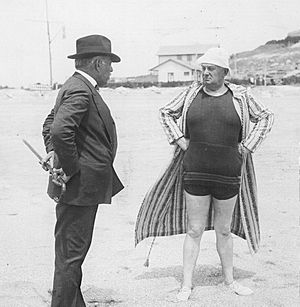
In 1926, a law (No. 11,357) was signed that gave women (single, divorced, or widowed) over 18 all the same civil rights as men. The government also started to support agricultural cooperatives. The Banco di la Nación was allowed to give financial help to these groups. Law No. 11388 officially recognized the cooperative movement and set rules for them.
International Relations
During Alvear's time, Argentina signed border agreements with Bolivia. They also tried to cancel the debt that Paraguay owed Argentina from the War of the Triple Alliance. There was also an effort to limit the size of warships with Chile.
On 30 October 1922, an agreement was signed to review the border between Argentina and Bolivia. After some discussions, the Carrillo-Díez de Medina treaty was signed on 9 July 1925. This agreement gave the town of Yacuiba to Bolivia.

On 6 August 1924, there were celebrations for the visit of Umberto of Savoy, the crown prince of Italy. Alvear invited the future king to watch a parade of 25,000 children in Congress Square.
From 1922, the government stopped postal and telegraph services to and from the Malvinas Islands. This was to pressure the British about Argentina's claim to the islands. The British protested, but Argentina said it was not an official measure. By March 1928, communications were back to normal, but Argentina still claimed the islands.
In 1923, at a meeting in Santiago de Chile, Chile suggested that Argentina and Chile limit their weapons. Argentina rejected the first proposal and offered a lower limit for warships, but this was also rejected. This caused relations with Chile to cool down.
On 24 March 1925, the famous scientist Albert Einstein and his wife arrived in Argentina. He stayed for a month and gave lectures about his theory of relativity. His visit showed how well Argentina was doing at the time. He even met with President Alvear.
On 17 August 1925, Edward of Windsor, the Prince of Wales (heir to the British crown), visited Argentina. Alvear organized a trip to a large ranch in the countryside. There, they listened to Carlos Gardel sing. The visits from the Prince of Wales and other royals cost a lot of money. Alvear decided to pay for half a million pesos of the expenses himself. He did this by selling part of his inherited lands in Don Torcuato.
Oil Policy
One of Alvear's first actions was to appoint General Enrique Mosconi as the head of Yacimiento Petrolifos Fiscales (YPF), the state oil company. Mosconi helped YPF grow with government support. His goal was for Argentina to produce all the oil it needed. He also worked to reduce competition between YPF and foreign companies.
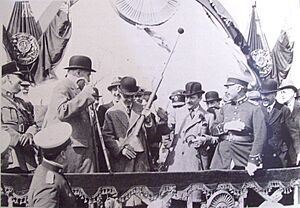
In 1925, the La Plata Industrial Complex was built for refining oil. This made Argentina independent from buying gasoline from other countries. This plant was the tenth largest oil refinery in the world. During Mosconi's eight years, oil production almost tripled. YPF opened its first kerosene pump in Buenos Aires in 1923. Soon after, the first gasoline pump for cars was built. YPF had fifty thousand employees.
Public and Cultural Works
During Alvear's time, many monuments and public buildings were constructed. Unlike the president before him, Alvear always attended ceremonies and social events. Important buildings like the Ministry of Finance and the National Bank in Plaza de Mayo began construction. He also supported culture by building theaters and museums. More public works were opened during his presidency than ever before.
In 1923, the Luján Museum was opened. In Buenos Aires, Mayor Carlos Noel did a great job. He finished the Paseo de la Costanera Sur and paved many city streets.
In 1923, the president suggested sending a team to the 1924 Paris Olympic Games. This idea didn't pass at first. But on 31 December, a decree was signed to create the Argentine Olympic Committee. This allowed Argentina to participate officially in the Olympic Games for the first time in 1924.
Alvear's wife, Regina Pacini, wanted to help artists who were struggling. She worked with others to create an institution to protect them. On 30 December 1927, they got land for this project. The Colón Theater held special shows to raise money. This is how the Casa del Teatro (House of the Theater) was born. Pacini also helped create the Municipal Radio 710 KHz. This radio station broadcast operas and concerts from the Colón Theater. This allowed people who couldn't go to the theater to listen to classical music.
The Radical Party Splits
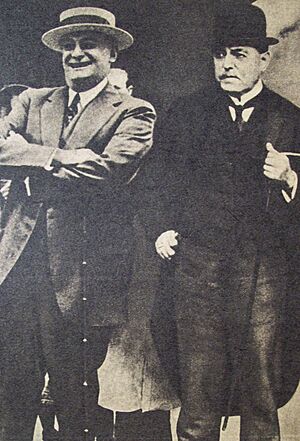
The radical party split in 1923. Nine radical senators declared themselves "anti-personalists," meaning they were against Yrigoyen's strong personal leadership. They supported President Alvear.
There were also problems between Alvear and his vice president, Elpidio González, who supported Yrigoyen. The split grew, and it moved to Congress. Deputies loyal to Yrigoyen tried to block Alvear's plans. They would even leave the building to stop votes from happening. Because of this, President Alvear closed the special sessions of Congress in January 1925, as there was almost no work being done.
1928 Presidential Election
The Radical Civic Union divided into two parties as the 1928 presidential elections came closer. One group, called "personalistas," supported Yrigoyen as president with Francisco Beiró. The other group, the UCRA, supported Leopoldo Melo and Vicente Gallo.
Yrigoyen won the 1928 elections by a lot, with 62% of the votes. He was elected president again. When Alvear went to hand over power on 12 October, some of Yrigoyen's supporters shouted "traitor!" at Alvear. Alvear tried to fight them, but people held him back. Alvear tried to fix things with Yrigoyen and visited him in December 1928, after not seeing him for several years.
Later Life
After his presidency ended, Alvear moved to Paris in 1930, a city he loved. While in Europe, his family and friends sent him letters about the difficult political situation in Argentina. He learned about the coup d'état by José Félix Uriburu. This didn't surprise him, as the economic crisis of 1929 and Yrigoyen's old age had weakened his power. Alvear decided to return to Argentina to help unite the radical party. He believed the new government was not democratic.
Return to Argentina
On 11 April 1931, Alvear sailed to Buenos Aires. He arrived on 25 April and was met by about 6000 people. General Justo and a representative of the de facto president José Félix Uriburu were also there. Alvear met with Uriburu, who offered him the presidency if he promised not to include Yrigoyen's supporters. Alvear refused and began working to unite the radical party.
On 20 July 1931, a small revolution broke out in the province of Corrientes. Even though it was quickly stopped, it gave Uriburu an excuse. The government said there was a terrorist plan and raided radical party offices. This forced many political leaders, including Alvear, to leave the country. On 28 July 1931, Alvear went into exile. He had written a statement that the government banned, so he had to spread it secretly.
When Yrigoyen died in July 1933, Alvear became the clear leader of the radical party. He led the party by respecting its rules and members. He showed how to bring people together.
1937 Presidential Election
On 2 January 1935, the party decided to end its boycott of elections. This meant the radical party would start running in elections again. Alvear campaigned for the first time, visiting many towns and giving speeches. However, some people criticized him for working with the current government's election system. By 1936, Alvear was strongly leading the party.
The radical party won in provincial elections in November 1935 and March 1936. Alvear campaigned in many provinces. In some areas, the elections were still unfair, but in others, they were more normal. The radical party won in provinces like Santa Fe, Buenos Aires, and Córdoba.
On 12 February 1937, Alvear met with President Justo. He wanted Justo to promise fair elections. The next day, the Interior Minister told Alvear that some parts of their talk would be followed, but this didn't happen. The elections in Santa Fe were still unfair.
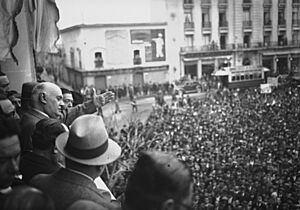
On 28 May 1937, the radical party voted for their presidential candidates. Alvear won the nomination for president. Enrique Mosca won the nomination for vice-president.
On 5 September 1937, a large crowd gathered at Luna Park to support Alvear for president. He was 69 years old. In the presidential elections, Roberto M. Ortiz won. Ortiz was a radical who had been a minister under Alvear. He got almost 42% of the votes. The radical party reported many cases of electoral fraud in most provinces, but Ortiz was still declared president. Alvear lost the election, which was not fair, but he kept fighting for the Constitution and democracy.
Both Alvear and Ortiz died in 1942. This meant neither of them lived long enough to see the end of the presidential term they had competed for. In his last years, Alvear traveled around the country for his party. Young radicals who later became important politicians, like Ricardo Balbín, joined him at political events.
Final Years and Passing
By the late 1930s, Alvear's health was getting worse. He had a bad flu and the political situation in Argentina was stressful. During a meeting, Alvear's resignation was read, but the committee refused to accept it. Alvear was too sick to see them, but he sent a message saying, "I am very ill, with one foot in the grave."
On 23 March 1942, Marcelo Torcuato de Alvear died from a heart attack at his home in Don Torcuato. His wife, Regina Pacini, was with him. Many people came to say goodbye, even though it was raining. The next day, his body was taken to the Casa Rosada and watched over by government officials. These were the same people who had stopped him from becoming president through unfair elections. Leaders who had won thanks to fraud, like Roberto Marcelino Ortiz and Agustín Pedro Justo, praised Alvear.
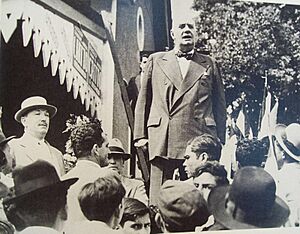
During his funeral, a crowd of people took his coffin from the official ceremony at the Casa Rosada. They carried it to the Recoleta Cemetery, shouting slogans against the government. His remains are in his family's tomb at the Recoleta Cemetery. He is buried with his grandfather Carlos María de Alvear and his father Torcuato de Alvear.
Tribute and Legacy
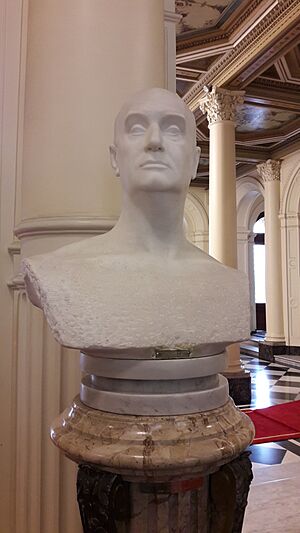
Many people believe Alvear was a good president. He led Argentina to progress during the successful 1920s. Cartoonists often drew Alvear's large figure. They showed him trying to fit into chairs or rushing to the beach in Mar del Plata. They also joked about his patience with the radical party's divisions. Cartoonists called him the bald man, as opposed to the hairy one who was Hipólito Yrigoyen.
The newspaper La Prensa honored Alvear, saying he was a citizen who served his country well. They said he was an example of good citizenship for fifty years. He showed that you can help your country from any position if you love it and want what's best for it.
One of the first tributes to Marcelo Torcuato de Alvear was the opening of the Presidente Alvear Theater. This happened on 23 March 1942, a month after he died.
The geographer Alberto María de Agostini named a mountain range in the Andes Mountains the Sierra Alvear. This range includes the highest peaks in the Argentine part of Tierra del Fuego. On 23 March 2017, for the 75th anniversary of Alvear's death, the UCR honored him at the Bicentennial Museum. A special area with his belongings was opened to remember him.
Many towns and streets are named after him and his family:
- Village Alvear, Santa Fe.
- Department General Alvear, Buenos Aires (Province).
- Municipality and village General Alvear, Misiones.
- Department General Alvear, Mendoza.
- Department General Alvear, Corrientes.
- City Alvear, Corrientes.
Honours
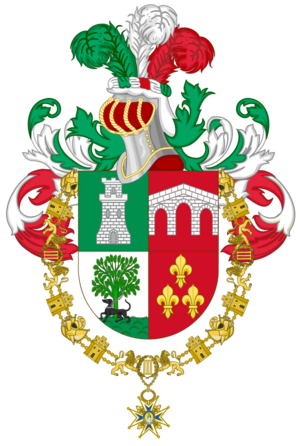
Decorations
| Award or decoration | Country | |
|---|---|---|
| Grand Cordon of the Order of Leopold | ||
| Grand Cross of the Order of Merit | ||
| Grade I, Clase I of the Cross of Liberty | ||
| Knight Grand Cross of the Order of the Legion of Honour | ||
| Knight Grand Cross of the Order of Saints Maurice and Lazarus | ||
| Knight Grand Cross of the Order of the Crown of Italy | ||
| Grand Cordon of the Order of the Rising Sun | ||
| Grand Cross of the Order of the Sun of Peru | ||
| Grand Cross of the Order of the Tower and Sword | ||
| Knight of the Collar of the Order of Charles III | ||
| Honorary Knight Grand Cross of the Order of the Bath | ||
| Knight Grand Cross of the Order of the British Empire | ||
| Grand Cordon of the Order of the Liberator | ||
| Grand Cross of the Order of Pope Pius IX | ||
See also
 In Spanish: Marcelo Torcuato de Alvear para niños
In Spanish: Marcelo Torcuato de Alvear para niños




